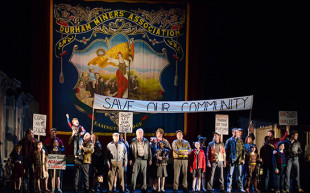This post contains affiliate links and our team will be compensated if you make a purchase after clicking on the links.
 Billy Elliot the Musical plays out amid the turmoil of one of the darkest times in modern British history – the 1984 coal miners’ strike. As young Billy studies ballet, despite the objections of his dad and the derision of his community, the mining town in which he lives experiences relentless hardship and despair. Money and food are scarce. Police eagerly clash with protesters.
Billy Elliot the Musical plays out amid the turmoil of one of the darkest times in modern British history – the 1984 coal miners’ strike. As young Billy studies ballet, despite the objections of his dad and the derision of his community, the mining town in which he lives experiences relentless hardship and despair. Money and food are scarce. Police eagerly clash with protesters.
Director Stephen Daldry, book writer and lyricist Lee Hall, composer Elton John, and choreographer Peter Darling deftly interweave the story of the miners’ struggles with Billy’s journey, which becomes a beacon of hope in a dying community.
The show, winner of 10 Tony Awards, is a powerful, seamless combination of riveting political theater and thrilling dance musical. Billy Elliot gleefully and savagely vilifies former Prime Minister Margaret Thatcher, architect of a policy to destroy the National Union of Mineworkers (NUM).
“It’s not possible to exaggerate how close Britain came to civil war,” says Daldry.
The memory of that time is still painful in Britain, but it’s a safe bet that the majority of people outside the UK know little or nothing about the country’s coal mining industry, and what transpired during those bleak days. Although one doesn’t need to be familiar with this part of British history to be thoroughly moved, uplifted, and inspired by Billy Elliot, knowledge of the conflict adds an even greater appreciation for the accomplishment of the creative team – the same artists, minus John, responsible for the 2000 film – and why they are so passionate about telling the miners’ story.
In 1984, the mineworkers’ union, with 250,000 members, was among the most powerful unions in Britain. The coal industry had been nationalized in 1947; in essence, the country owned it. Thus, the miners felt they were invested in the industry, a stark contrast to the United States, where the industry is privatized.
“The profits and the use of that resource were commonly held, just like a library or school,” says Hall, who grew up in a coal-mining town in North East England, similar to where Billy Elliot takes place.
The NUM had gone on strike in 1972 and 1974, both times over wages. During the second strike, Prime Minister Edward Heath declared a state of emergency, and instituted a three-day workweek in an attempt to conserve energy. At that time, Britain got most of its energy from coal, and Heath hoped that the public would blame the union for the blackouts and massive disruptions they were regularly experiencing.
“Instead, distaste for the government grew,” says Hall. “It became a politically unstable situation, and a general election was held.”
Heath and his Conservative (or Tory) party were voted out, and the Labour Party, led first by Prime Minister Harold Wilson and then by James Callaghan, was voted in. The NUM flourished.
In the aftermath of the Conservatives’ defeat, Nicholas Ridley, a right-wing member of parliament, drew up a plan advising the Tories how to conquer and dismantle the coal industry the next time their party took power.
This “Ridley Report” advocated buying and stocking foreign coal and oil resources, so that if the coal miners struck again, the public would not feel the effect. Ridley also suggested that the country “train and equip a large, mobile squad of police, ready to employ riot tactics in order to uphold the law against violent picketing.” His ideas were supported by Margaret Thatcher, who became leader of the Conservative party in 1975, and prime minister of Britain four years later.
“She wanted to reduce the political influence of trade unions,” says Hall. “Her ideology and economic outlook was based on privatizing, on letting big business look after public needs. After she took office, there were plans to shut down 23 individual mines that were ‘uneconomical.’”
But this time, the government backed off when the miners threatened to strike.
When Thatcher won re-election in 1983, thanks mainly to the success of the Falklands War, Britain was a very divided nation.
“Her economic policies had resulted in massive unemployment in certain areas,” says Hall. “One of those areas was the North East of England. The southern part of the country was doing very well, but in northern, industrial, working-class Britain, unemployment was between 20 and 25 percent.”
And things were about to get worse, as Thatcher decided to implement Ridley’s plan. Coal from abroad was stockpiled, and many power stations were switched over to oil. The National Coal Board announced that 20 mines would be closed, including one in Yorkshire at Cortonwood.
“Ironically, they’d spent a million pounds the year before to make that pit more modern,” says Hall. “So it was clear to the mining union that this was not about whether the pits were economical. This was a political and ideological fight.”
Miners at Cortonwood and several other pits went out on strike. For a variety of reasons, no official vote was taken of the union, but the president of the NUM, Arthur Scargill, declared a national strike in March 1984.
“It became confrontational very quickly,” says Hall. “And the level of policing was very disproportionate. Violence erupted, because the police were very antagonistic. The local policemen were put in a very ambiguous situation, because their livelihoods were dependent on the continued existence of the industry. So Thatcher sent a lot of London police up north. They wore riot helmets. From the start they were very pumped up, and very quickly they were far too aggressive. And when things got violent, it became a common occurrence for the police to arrest ‘troublemakers’ in their houses. The streets would be flooded with policemen who would break down doors, and bring out ringleaders of the union who had supposedly committed violence on the picket line. Sure there was violence by the pickets. But there was also violence by the police. It escalated, and there were pit battles, including a very famous one called Orgreave. The police, on horses, with their riot shields, attacked and beat up many miners. There was blood all over.”
In order to stop miners from traveling to other villages to support their striking colleagues, roadblocks were set up on highways.
“My dad had to travel for work,” says Hall. “He wasn’t a miner, but he had a Geordie accent [the Northern English dialect], so he was believed to be a miner. He was sent home, and couldn’t do his work. It was shocking to have our civil liberties curtailed. We thought we were civilized people.”
Unlike in the previous decade, the miners did not have widespread public support. Many members of the media abetted Thatcher by presenting just one side of the story.
“Thatcher put a lot of pressure on the BBC to say that the miners were only interested in violence,” says Hall. “All you saw on the telly were these evil, vicious miners, and claims were made that they were probably funded by the Soviets. Thatcher called them ‘the enemy within.’ You never saw that these villages were under siege, and that violence was being perpetrated against ordinary families. You only saw the retaliation.”
Scargill, the NUM president, made a fatal tactical error by not validating the strike with an official ballot. Thatcher and the Tories had instituted and enforced a law that mandated a vote by union members in order to strike. Because the strike wasn’t “officially” authorized, the Trades Union Congress – a federation of unions – failed to back the miners. The opposition Labour party, which theoretically supported the union, also refused to officially endorse the strike.
“About six months in, it became clear that the miners had been hung out to dry by politicians who were supposedly in their camp,” says Hall. “People were very embittered; so many were directly affected. You had about 250,000 miners out of work, and all the subsidiary industries that couldn’t work, and all of the families that were reliant on these incomes. So there were more than a million people, maybe even two million, who were not getting a wage, who couldn’t claim benefits, who had no food. They were supported by ordinary people. Wherever you went there were buckets, and you put your money in the buckets. That went to buy food for the miners and their families. In the musical we have people send gifts for the kids of the miners. That happened all the time.”
Thatcher had the resources to do whatever she wanted.
“Because they stockpiled coal, the strike did not have much effect,” says Hall. “The government was spending about four million pounds each week to wage this strike against their own employees, against a proud part of the country’s economic and cultural heritage. After a year, the resources of the state were infinite, and the miners were broke. Very gradually, people started to drift back to work. It became quite clear that the strike was going to be broken, and Thatcher had won.”
The government immediately started closing the pits. Thatcher was followed as prime minister by another Conservative, John Major. By the time he left office in 1997, 80 percent of the coal mining industry had been shut down. Other pits were sold off and privatized. The number of miners had dwindled to about 5000.
“They literally went down and cut the wires on the cages, threw things down the mine shafts and obliterated the mechanisms so that the pits couldn’t be used again,” says Hall. “A third of our energy still comes from coal, but that coal is imported from Ukraine. We lost the industry.”
At the end of Billy Elliot, it’s clear that the mining community is on a path to nowhere. But Billy is poised to go in a different direction. His talent and passion lift the spirits, as he heads down a road filled with infinite possibilities.
Billy Elliot the Musical is playing at Segerstrom Center for the Arts April 16 – 28, 2013! Get your tickets now.











